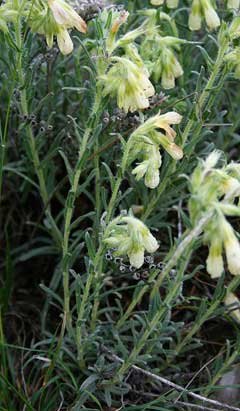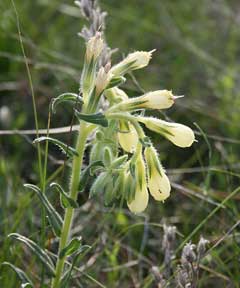 |
|
http://commons.wikimedia.org/wiki/User:Franz_Xaver |
 |
| http://commons.wikimedia.org/wiki/User:Franz_Xaver |
Translate this page:
Summary
Physical Characteristics

 Onosma echioides is a PERENNIAL growing to 0.3 m (1ft).
Onosma echioides is a PERENNIAL growing to 0.3 m (1ft).
See above for USDA hardiness. It is hardy to UK zone 7. It is in flower from June to August. The species is hermaphrodite (has both male and female organs) and is pollinated by Insects.
Suitable for: light (sandy) and medium (loamy) soils and prefers well-drained soil. Suitable pH: mildly acid, neutral and basic (mildly alkaline) soils. It cannot grow in the shade. It prefers dry or moist soil and can tolerate drought.
UK Hardiness Map
US Hardiness Map
Synonyms
Plant Habitats
Cultivated Beds; South Wall. In. West Wall. In.
Edible Uses
References More on Edible Uses
Medicinal Uses
Plants For A Future can not take any responsibility for any adverse effects from the use of plants. Always seek advice from a professional before using a plant medicinally.
Alterative Laxative Poultice Stimulant
The leaves are alterative[240]. They are made into a powder and given to children as a purgative[240]. The flowers are used as a cordial and stimulant in the treatment of rheumatism and palpitations of the heart[240]. The root is bruised and used as an external application to skin eruptions[240].
References More on Medicinal Uses
The Bookshop: Edible Plant Books
Our Latest books on Perennial Plants For Food Forests and Permaculture Gardens in paperback or digital formats.

Edible Tropical Plants
Food Forest Plants for Hotter Conditions: 250+ Plants For Tropical Food Forests & Permaculture Gardens.
More

Edible Temperate Plants
Plants for Your Food Forest: 500 Plants for Temperate Food Forests & Permaculture Gardens.
More

More Books
PFAF have eight books available in paperback and digital formats. Browse the shop for more information.
Shop Now
Other Uses
Dye
A red dye is obtained from the root. It is an alkanna substitute[46, 61].
Special Uses
References More on Other Uses
Cultivation details
Requires a well-drained soil in full sun[1, 187]. Prefers a deep rather rich sandy loam[1]. Best grown in a crevice in a rock garden or on a wall[1, 187]. Tolerates hot dry conditions and also drought once it is established, but disliking winter wet[190]. Plants also dislike wet summers[200]. Hardy to about -15°c[187]. There is some confusion over this species. It is given as a part of O. frutescens in some reports but [200] gives it specific status. A very ornamental plant[1].
References Carbon Farming Information and Carbon Sequestration Information
Temperature Converter
Type a value in the Celsius field to convert the value to Fahrenheit:
Fahrenheit:
The PFAF Bookshop
Plants For A Future have a number of books available in paperback and digital form. Book titles include Edible Plants, Edible Perennials, Edible Trees,Edible Shrubs, Woodland Gardening, and Temperate Food Forest Plants. Our new book is Food Forest Plants For Hotter Conditions (Tropical and Sub-Tropical).
Shop Now
Plant Propagation
Seed - we have no information on this species but suggest sowing the seed in a greenhouse in early spring. Prick out the seedlings into individual pots as soon as they are large enough to handle and grow them on in the greenhouse for at least their first winter. Plant them out in early summer. Cuttings in a frame in the summer. Shade them for the first 10 - 12 days[1].
Other Names
If available other names are mentioned here
Native Range
EUROPE: Albania, Croatia, Italy (incl. Sicily), Turkey (Edirne, Istanbul)
Weed Potential
Right plant wrong place. We are currently updating this section.
Please note that a plant may be invasive in one area but may not in your area so it's worth checking.
Conservation Status
IUCN Red List of Threatened Plants Status :

Growth: S = slow M = medium F = fast. Soil: L = light (sandy) M = medium H = heavy (clay). pH: A = acid N = neutral B = basic (alkaline). Shade: F = full shade S = semi-shade N = no shade. Moisture: D = dry M = Moist We = wet Wa = water.
Now available:
Food Forest Plants for Mediterranean Conditions
350+ Perennial Plants For Mediterranean and Drier Food Forests and Permaculture Gardens.
[Paperback and eBook]
This is the third in Plants For A Future's series of plant guides for food forests tailored to
specific climate zones. Following volumes on temperate and tropical ecosystems, this book focuses
on species suited to Mediterranean conditions—regions with hot, dry summers and cool, wet winters,
often facing the added challenge of climate change.
Read More
Expert comment
Author
L.
Botanical References
89200
Links / References
For a list of references used on this page please go here
Readers comment
© 2010, Plants For A Future. Plants For A Future is a charitable company limited by guarantee, registered in England and Wales. Charity No. 1057719, Company No. 3204567.